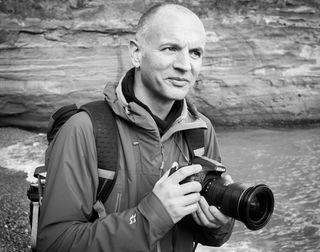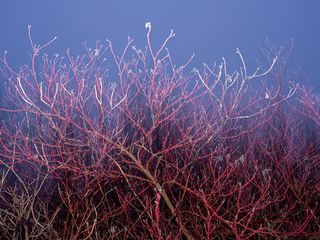
Benedict Brain is a UK-based photographer, journalist and artist. He is an Associate of the Royal Photographic Society and sits on the society’s Distinctions Advisory Panel. He is also a past editor of Digital Camera Magazine, and the author of You Will be Able to Take Great Photos by The End of This Book.
The magical red of dogwood twigs is one of the joys of the winter landscape for me. The bare skeletal structures of trees and plants in general appeal to my aesthetic sensibilities: I find their delicate shapes more interesting than the lush green foliage of summer. Perhaps this speaks to my state of mind. Who knows?
This patch of wild dogwood was captured on a route along the River Avon in Bath, near where I live. It’s a flood zone that is enduringly fascinating to me, and rich with photographic potential. It’s along a path that I run down regularly, so even when I’m without my camera, I delight in its ever-changing appearance and make photos in my mind’s eye.
On this particular day in early January, it was super-cold and, even in the late afternoon, the frost hadn’t melted away. I’d never seen it looking quite so exquisite so, as soon I was home from my run, I grabbed my kit and headed back out to shoot photos.
It was twilight by the time I got back to the location. I made some images with a tripod, but I wasn’t capturing the ‘magical’ vibe I was feeling, so I decided to ditch the tripod and use an on-camera flash on my medium-format Fujifilm GFX. Using manual exposure, I balanced the sky with flash, lighting the dogwood. Bingo! The flashgun light accentuated the red hues of the twigs and captured the glistening frost with a sparkle. The harmonious relationship between the colors of the twilight sky and the twigs seemed perfect to me.
It’s not typical to use on-camera flash in landscape photography, but I’m finding that I’m increasingly drawn to it. I’m seduced by the otherworldly rendering of the land and its features that the artificial light produces, and perhaps the maverick approach appeals to my inner rebel.
In a way, this image also reminds me of an underwater scene: the combination of the color palette and the sea fern-esque shape of the twigs echo a coral reef.
• Other articles in the Art of Seeing series
Read more:
• The 50 best photographers ever
• 100 best photography quotes from famous photographers
• The best coffee-table books on photography






